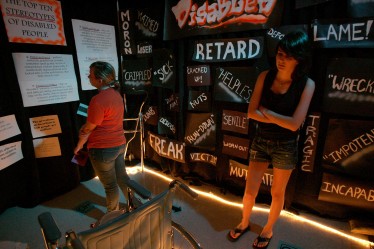
Students at University of Miami walk through Tunnel of Oppression
(4-29-16) How do you get someone to understand what it might be like to experience a mental disorder?
Student members of the National Alliance on Mental Illness campus group at Indiana State University in Terre Haute decided to educate their peers by adding a mental health room to the school’s annual “Tunnel of Oppression” event. Many colleges host “tunnel events,” often sponsored by the NAACP or a school’s residential life organization to call attention to how students often stigmatize and marginalize others. This was the first year that the ISU campus chapter of NAMI added a Tunnel of Oppression room that focused exclusively on mental disorders.
“Tunnel of Oppression doesn’t sound too inviting,” ISU student Charlene Johnson explained during lunch when I visited ISU recently to speak. “But we got really positive feedback here and students overwhelmingly reported that the experience felt much more real than they had expected.”
Johnson and her professor, Dr. Jennifer Schriver, described the NAMI tunnel to me. I’ll let Charlene tell you.
When participants came into the room, they were assigned one of the three mental health conditions: either depression, anxiety, or schizophrenia. To simulate what it feels like to be depressed, students put on a heavy backpack, and weights were placed around their wrists to simulate the oppressive weight that comes with depression. If a student was assigned anxiety, he or she had plugs stuffed into their ears to muffle their hearing and eyeglasses with only a pinhole opening to see through; this was to simulate how a person might feel during an anxiety attack when their world is closing in on them. Students assigned schizophrenia were given headphones that had recorded voices talking and at times screaming insults at them so they could sense what it is like to have negative and distracting voices in their heads.
But wait, that was just the beginning. Here’s the next step.
The participants were read a brief story. This helped them realize how difficult it might be for someone with a mental illness to focus on what is happening around them and follow instructions. After hearing the story, each student was taken into a tunnel. The depressive tunnel was very bleak, the anxiety tunnel was wildly colored, and decorations inside the schizophrenia tunnel were chaotic. Inside each were negative words that are commonly associated with each of these conditions. As each student walked through these tunnels, they were told to find words and symbols that were relevant to the story that they’d just heard and to write them on a slip of paper. Because of their disorders, finding all of these words or phrases was difficult.
Now comes another test.
When they came out of the tunnels, we gave each of them a task. The person with depression was led to a sandbox and told that there was a specific item hidden in the sand. They were told that they had to find it before their time was up. What they didn’t know was that there was nothing in the box except for sand. This was done to simulate the frustration and hopelessness that someone with depression might feel. The students with anxiety were told to put together a 42 piece Lego project. Of course, it was difficult for them to hear instructions and see through the pin hole glasses so they had to struggle and feel even more anxious. Finally, the student given the schizophrenic condition was handed a picture that had items hidden in it. Finding them was difficult especially when various sounds, commands, and voices were distracting you and berating you.
When the students were done with the experience, they were given a paper that explained what they had just been through, information about mental illnesses and a Hershey’s hug and kiss candy.
Of course, persons with depression, anxiety, and schizophrenia don’t get a candy reward nor do they get to take off the weights, remove the earplugs and pinhole glasses, and turn off the voices in their heads at will. And a cynic would complain that it is impossible for anyone to simulate what it feels like to be depressed, anxious and delusional. But I participated in a simulation exercise when my father was sick that involved dementia and it opened my eyes to what he was experiencing. It was a worthwhile exercise that led to me being much more patient and understanding.
Charlene Johnson at cpopejoy@sycamores.indstate.edu and Dr. Jennifer Schriver at Jennifer.Schriver@indstate.edu felt the students who participated, not only exited with a better understanding of mental illnesses, but also with more empathy toward persons who were struggling.
Bravo to NAMI’s campus chapter for including mental disorders in this national trend! Spread the word!

Photo from left to right: Kymberlee Blackford NAMI ISU VP, Kassie deArmas, Charlene Johnson NAMI ISU President, Dana Hobbs, and Logan Buck



